Types of Headsets
Types of Headsets by Category:
 |
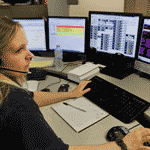 |
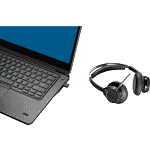 |
 |
 |
| Office & Contact Center | 911 Center | Dispatch | Computer | Cell Phone | Bluetooth | Conferencing |
Choose by Workstyle Solutions:
 1 | OFFICE COLLABORATOR:
1 | OFFICE COLLABORATOR:
The office collaborator has an office-based workstyle, is highly collaborative and open to new technology. As many of office collaborators work in open office spaces and spend the majority of the day at their desk, their pain points include background noise and constant disruptions. They want to seamlessly manage their communication across devices.
- Occurrence in a typical enterprise: 27%
- Communication intensity: High
- Location: Office
-
Communication Needs: PC, Emails, IM & video
-
Headset usage 67%
-
Video usage 46%
OFFICE COLLABORATOR CHALLENGES
- Ability to connect to multiple devices
- Preventing sounds in your environment from being heard on call
- Focus on calls, not the noise around you
- Freezing video during calls
AN OFFICE COLLABORATOR FEELS AS PRODUCTIVE AT HOME AS IN THE OFFICE
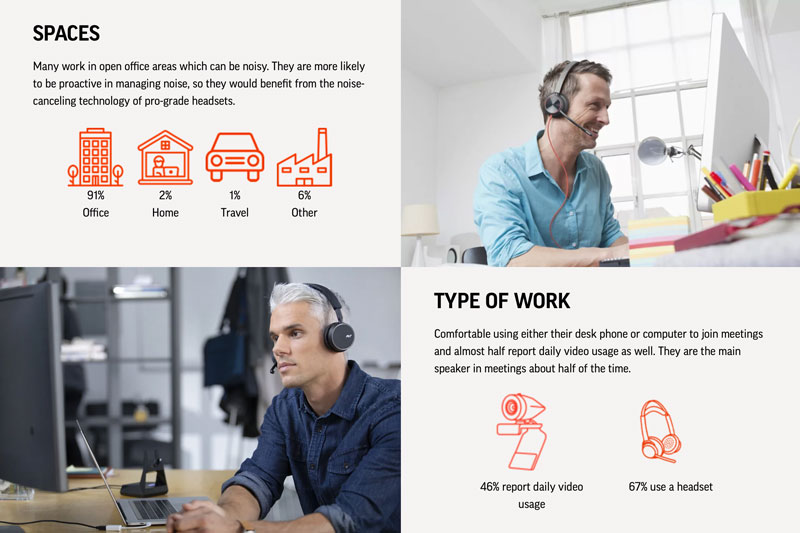

WORKSTYLE:
As an Office Collaborator you are career focused, optimistic and open to new technology. You appreciate teamwork and have a lot of face-to-face communication in a typical day, but you also spend a good deal of time collaborating on calls. You spend most of your work time in the office and can be found at your desk in online meetings or working on projects.
COMMUNICATION:
You are flexible in your communication style, primarily using your computer or mobile phone for calls. You are comfortable hopping between IM, email, text, voice calls and even video. When it comes to new technology you are quick to adopt and believe technology makes collaboration and workflows more efficient and convenient.
PAIN POINTS:
You may work in an open office area which can be noisy due to the people around you. This leads to background noise during calls and may impact your ability to focus. When remotely collaborating, top pain points include: lag between audio/visuals on video calls, poor video quality, and you may find headsets become uncomfortable when on longer calls.
Recommended Solutions:
-
$147.86
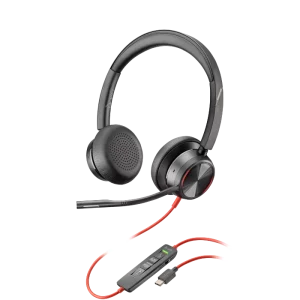 Poly Blackwire 8225 UC USB Headset(PC + Mobile) & Teams VersionSelect options
This product has multiple variants. The options may be chosen on the product page
Poly Blackwire 8225 UC USB Headset(PC + Mobile) & Teams VersionSelect options
This product has multiple variants. The options may be chosen on the product page
-
$144.59
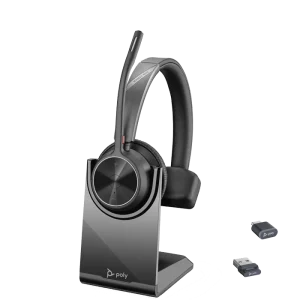 Poly Voyager 4310 UC (Stand)(PC + Mobile) & Teams VersionSelect options
This product has multiple variants. The options may be chosen on the product page
Poly Voyager 4310 UC (Stand)(PC + Mobile) & Teams VersionSelect options
This product has multiple variants. The options may be chosen on the product page
-
$219.98
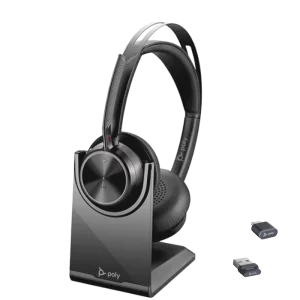 Poly Voyager Focus 2 UC Headset (w/Stand)(PC + Mobile) & Teams VersionSelect options
This product has multiple variants. The options may be chosen on the product page
Poly Voyager Focus 2 UC Headset (w/Stand)(PC + Mobile) & Teams VersionSelect options
This product has multiple variants. The options may be chosen on the product page
 2 | FLEXIBLE WORKER:
2 | FLEXIBLE WORKER:
The flex worker splits time between the corporate office, a home office and travel. They are always innovating and adapting their communications channels. Due to frequent remote and on-the-go work, pain points include difficulty collaborating with colleagues and missing important information in the office. The flex worker needs to be “always-on” and communicate across several devices.
- Occurrence in a typical enterprise: 20%
- Communication intensity: Medium
- Location: Multiple
-
Communication Needs: Mobile, PC, IM, email
-
Headset Usage 73%
-
Video usage 47%
FLEX WORKER CHALLENGES
- Sounding clear in a variety of environments
- Managing connectivity to multiple devices
- Keeping devices charged
- Poor video quality
A FLEXIBLE WORKER FEELS AS PRODUCTIVE AT HOME AS IN THE OFFICE
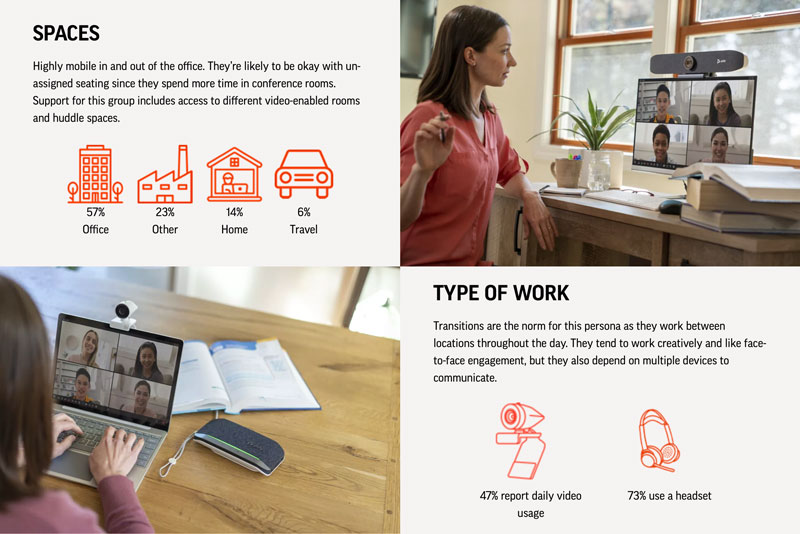

WORKSTYLE:
As a Flexible Worker, you are generally confident, optimistic and “always on”. You are used to adapting to different situations; there is rarely such a thing as a “typical” day. You are communicative and often play a lead role in your meetings. Though you may have a desk in an office, you only spend about half of your time there. The rest of your time may be spent in conference rooms, working from home, traveling or at other locations off-site.
COMMUNICATION:
You prefer face-to-face communication for relationship-building, but your communication style is highly flexible. You easily switch between IM, email, voice and video calls. You are always connected and may have trouble disconnecting from work when on vacation. Your smartphone is your lifeline for staying connected as you move between locations. When it comes to new technology, you are among the first to adopt.
PAIN POINTS:
You often have difficulty getting connected while traveling or at home. You may struggle with call/video quality due to poor connections. Background noise is a major issue that you experience in your multiple work locations, and it can really impact your focus and productivity. You may find headsets become uncomfortable when worn for long periods on calls.
Recommended Solutions:
-
$149.20
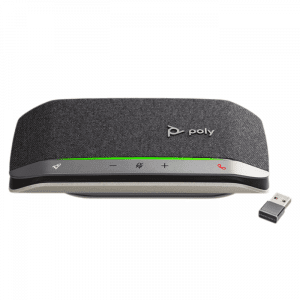 Poly Sync 20+ Speakerphone with USB Dongle(USB & Bluetooth) + Microsoft Teams ButtonSelect options
This product has multiple variants. The options may be chosen on the product page
Poly Sync 20+ Speakerphone with USB Dongle(USB & Bluetooth) + Microsoft Teams ButtonSelect options
This product has multiple variants. The options may be chosen on the product page
-
$144.59
 Poly Voyager 4310 UC (Stand)(PC + Mobile) & Teams VersionSelect options
This product has multiple variants. The options may be chosen on the product page
Poly Voyager 4310 UC (Stand)(PC + Mobile) & Teams VersionSelect options
This product has multiple variants. The options may be chosen on the product page
-
$219.98
 Poly Voyager Focus 2 UC Headset (w/Stand)(PC + Mobile) & Teams VersionSelect options
This product has multiple variants. The options may be chosen on the product page
Poly Voyager Focus 2 UC Headset (w/Stand)(PC + Mobile) & Teams VersionSelect options
This product has multiple variants. The options may be chosen on the product page
 3 | REMOTE COLLABORATOR:
3 | REMOTE COLLABORATOR:
Working from a home office or a remote center, the remote worker has fewer opportunities for in-person meetings and more challenges to successful and productive collaboration. Remote workers depend on multiple devices, unified communications and technologies to bridge the gaps between them and their colleagues, co-workers and clients.
- Occurrence in a typical enterprise: 15%
- Communication intensity: High
- Location: Home
-
Communication Needs: PC, Mobile, IM & video
-
Headset usage 75%
-
Video usage 51%
REMOTE COLLABORATOR CHALLENGES
- Need highly portable solutions
- Sounding professional in a variety of environments
- Mute awareness
- Grainy video quality
A REMOTE COLLABORATOR FEELS SIGNIFICANTLY MORE PRODUCTIVE AT HOME VS THE OFFICE
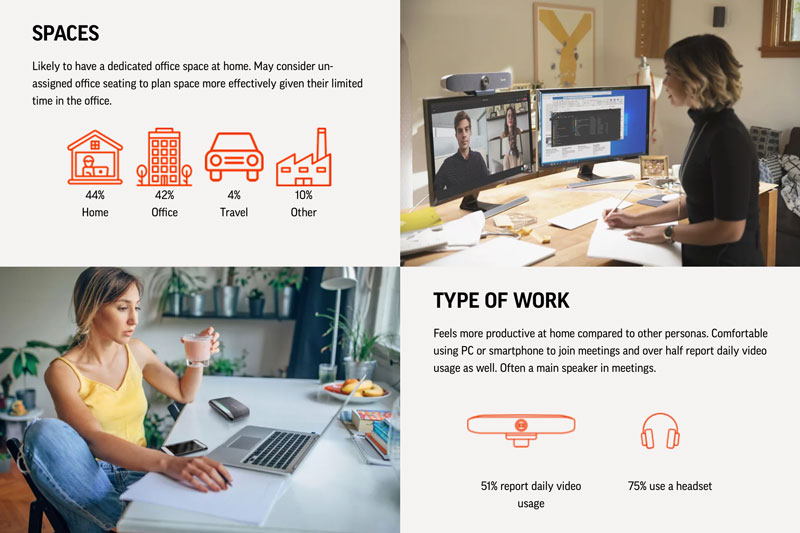

WORKSTYLE:
As a Remote Collaborator, you appreciate that your job has created an ideal work-life balance for you. Though you may spend some of your work week in the office, you spend a good amount of time working at home. On the rare occasions you go into the office, you may not have a designated workspace, and will often spend time in conference rooms for important meetings.
COMMUNICATION:
You completely rely on the internet at your home, if it shuts down you become very limited in which tasks you can complete. Good connectivity is also very important since you take a lot of voice, video, and conference calls. Your PC and mobile phone are your primary communication devices. You are able to use technology to effectively collaborate and like to stay on top of the latest technology trends.
PAIN POINTS:
You can feel a little isolated from what is happening in the office and miss the impromptu social interactions colleagues in the office have such easy access to. Noise and distraction at home make it tough to concentrate especially on conference calls. You may also struggle with poor connections and lags between audio and video on calls.
Recommended Solutions:
-
$149.20
 Poly Sync 20+ Speakerphone with USB Dongle(USB & Bluetooth) + Microsoft Teams ButtonSelect options
This product has multiple variants. The options may be chosen on the product page
Poly Sync 20+ Speakerphone with USB Dongle(USB & Bluetooth) + Microsoft Teams ButtonSelect options
This product has multiple variants. The options may be chosen on the product page
-
$144.59
 Poly Voyager 4310 UC (Stand)(PC + Mobile) & Teams VersionSelect options
This product has multiple variants. The options may be chosen on the product page
Poly Voyager 4310 UC (Stand)(PC + Mobile) & Teams VersionSelect options
This product has multiple variants. The options may be chosen on the product page
-
$219.98
 Poly Voyager Focus 2 UC Headset (w/Stand)(PC + Mobile) & Teams VersionSelect options
This product has multiple variants. The options may be chosen on the product page
Poly Voyager Focus 2 UC Headset (w/Stand)(PC + Mobile) & Teams VersionSelect options
This product has multiple variants. The options may be chosen on the product page
 4 | OFFICE COMMUNICATOR:
4 | OFFICE COMMUNICATOR:
As a more traditional work style, the office communicator is most comfortable with familiar systems and devices (like a desk phone). Due to the high percentage of time they spend communicating in the office, their pain points include being diverted by interruptions, background noise and lack of privacy on calls.
- Occurrence in a typical enterprise: 13%
- Communication intensity: Low
- Location: Office
-
Communication Needs: Desk phone, Emails & in-person
-
Headset usage 33%
-
Video usage 5%
OFFICE COMMUNICATOR CHALLENGES
- Simple call management between desk phone and PC
- To hear and be heard clearly
- Comfortability of headsets
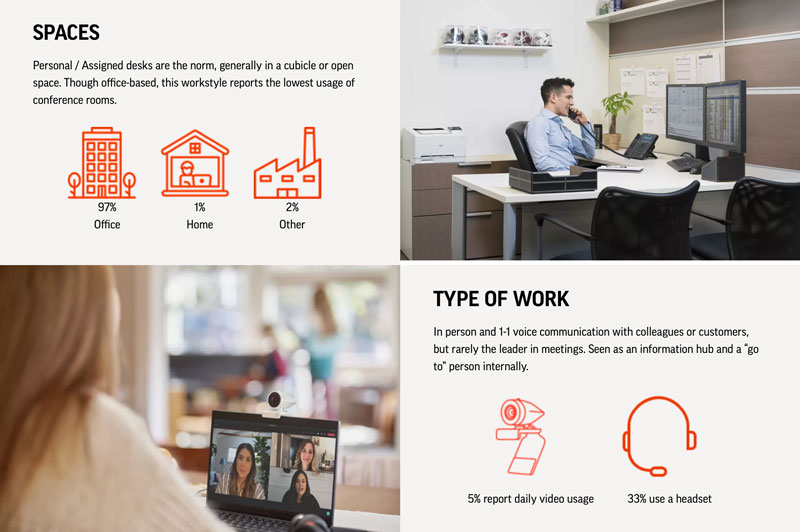

WORKSTYLE:
As an Office Communicator, communicating with colleagues or customers is a major part of your workday. You spend the majority of your time working in the office at your desk, and you have a lot of face-to-face communication with nearby colleagues. When you are at work, you are always connected and “in the know”. You enjoy your work but believe in balance, so you rarely bring work home.
COMMUNICATION:
Though you spend a lot of time communicating, voice calls may be a preferred mode of communication (as opposed to video). You spend a lot of time emailing but get frustrated with the distractions IM’s can cause. When it comes to newer collaboration technologies, you like to use proven tools that are easy to use. You feel if the complexity and kinks of these technologies can be worked out, you would be more open to using them.
PAIN POINTS:
Many Office Communicators work in open office areas which are not very private and can be noisy due to nearby conversations and overall room noise. Noise and distraction make it tough to concentrate and difficult to understand people speaking during calls. You may also get complaints from those on the far end of your calls regarding the noise in your background.
Recommended Solutions:
-
$318.23
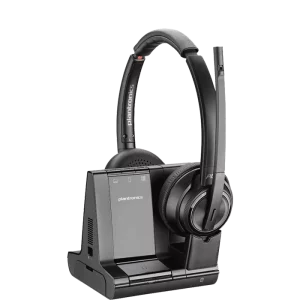 Poly Savi 8220 Office Wireless Headset(Desk Phone + PC + Mobile) & Teams VersionSelect options
This product has multiple variants. The options may be chosen on the product page
Poly Savi 8220 Office Wireless Headset(Desk Phone + PC + Mobile) & Teams VersionSelect options
This product has multiple variants. The options may be chosen on the product page
-
$221.34
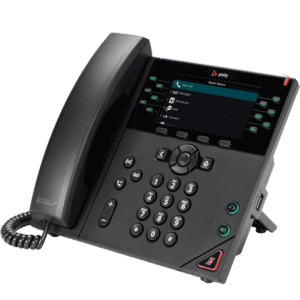 Poly VVX 450 Business IP PhoneAdd to cart
Poly VVX 450 Business IP PhoneAdd to cart
-
$85.79
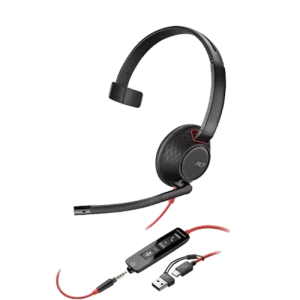 Poly Blackwire 5210 USB Headset – 8X230AA(PC + 3.5mm)Add to cart
Poly Blackwire 5210 USB Headset – 8X230AA(PC + 3.5mm)Add to cart
 5 | CONNECTED EXECUTIVE:
5 | CONNECTED EXECUTIVE:
Connected executives are tech-savvy business drivers who go wherever needed to make decisions and solve problems. Due to the fact that they are so versatile in their work style, their pain points include diversions, interruptions and unpredictable background noise. They use more communication tools than any other persona, so they have to stay connected across all devices.
- Occurrence in a typical enterprise: 12%
- Communication intensity: High
- Location: Multiple
-
Communication Needs: Mobile/tablet, PC Calls, text IM & in-person
-
Headset usage 81%
-
Video usage 79%
CONNECTED EXECUTIVE CHALLENGES
- Ability to connect to multiple devices
- Preventing sounds in your environment from being heard on calls
- Being able to focus and concentrate
- Looking and sounding professional on calls
A CONNECTED EXECUTIVE FEELS AS PRODUCTIVE AT HOME AS IN THE OFFICE.
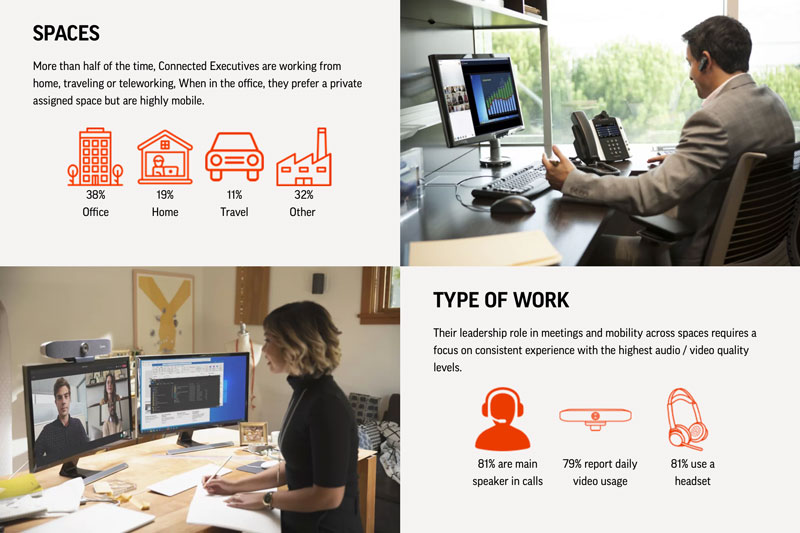

WORKSTYLE:
As a Connected Executive, you are an optimistic person – you’d rather see the solution than the problem and you can easily motivate others. You work in multiple locations and pride yourself on being able to work from anywhere. You strive to always be connected and may even have trouble disconnecting from work when on vacation.
COMMUNICATION:
You appreciate working with a team and have a variety of communication modes, from one-to-one, to one-to-many. You often play a lead role in the meetings you participate in.When it comes to new technology you are among the first to adopt. You believe technology improves workflows and makes collaboration with colleagues more efficient.
PAIN POINTS:
One of your main collaboration challenges is you sometimes have difficulty getting connected, especially while traveling or at home.You are prone to experiencing background noise during calls in your multiple work locations. Compatibility and transition issues between work devices as well as lags between audio and video on calls are frequent pain points.
Recommended Solutions:
-
$189.72 – $208.69
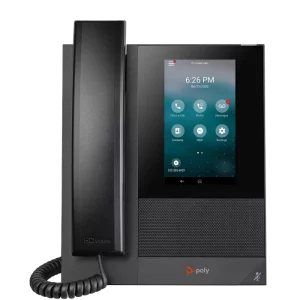 Poly CCX 400 Business Media Phone(Touch Screen) Teams VersionSelect options
This product has multiple variants. The options may be chosen on the product page
Poly CCX 400 Business Media Phone(Touch Screen) Teams VersionSelect options
This product has multiple variants. The options may be chosen on the product page
-
$144.59
 Poly Voyager 4310 UC (Stand)(PC + Mobile) & Teams VersionSelect options
This product has multiple variants. The options may be chosen on the product page
Poly Voyager 4310 UC (Stand)(PC + Mobile) & Teams VersionSelect options
This product has multiple variants. The options may be chosen on the product page
-
$219.98
 Poly Voyager Focus 2 UC Headset (w/Stand)(PC + Mobile) & Teams VersionSelect options
This product has multiple variants. The options may be chosen on the product page
Poly Voyager Focus 2 UC Headset (w/Stand)(PC + Mobile) & Teams VersionSelect options
This product has multiple variants. The options may be chosen on the product page
 6 | ROAD WARRIOR:
6 | ROAD WARRIOR:
Always on the move, road warriors work outside of the office more than 50% of the time. Due to their constantly changing environment, their pain points include noise on calls and unreliable connections. They also travel light, so they want solutions that are highly portable and easy to use.
- Occurrence in a typical enterprise: 5%
- Communication intensity: Medium
- Location: On-the-go
-
Communication Needs: Mobile is lifeline Connects to: PC, car
-
Headset usage 62%
-
Video usage 32%
ROAD WARRIOR CHALLENGES
- Staying connected on the go
- Sounding professional in noisy environments
- Keeping devices charged
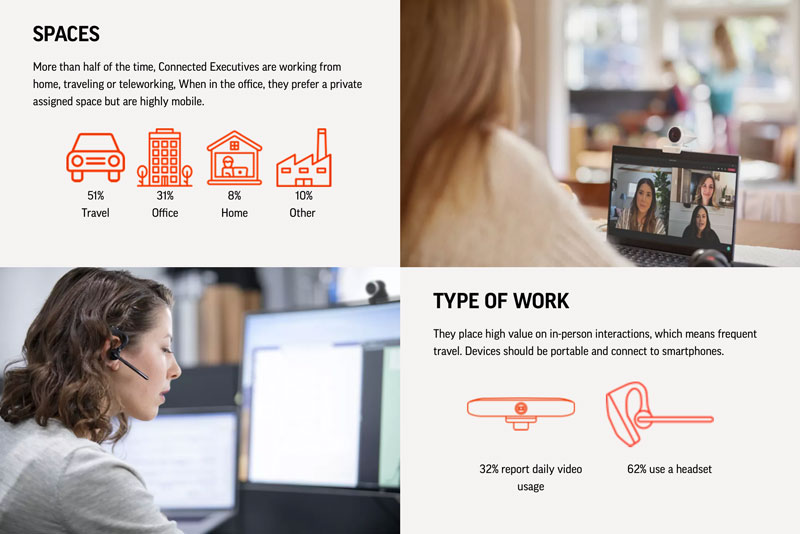

WORKSTYLE:
As a Road Warrior, you are generally self-confident, optimistic and sociable. You love your job and no matter what is going on, you are never offline. You are used to adapting to different situations and environments because you are constantly on the move. Though you may have an office, you spend the majority of your time traveling or working at other offsite locations.
COMMUNICATION:
You are regularly in transit and constantly need to communicate with clients and colleagues as you are trying to move projects/deals along. Your smartphone is your lifeline for staying connected but you are comfortable switching between IM, email, text, and calls. You prefer established technologies and don’t feel the need to buy the latest gadget. You just need your tools to work.
PAIN POINTS:
You want to sound professional on calls, but background sounds in your environment may undermine this. You also have a hard time hearing others in the loud environments you find yourself in. You struggle to get consistent connectivity when you travel, weak Wi-Fi networks and spotty cell coverage impact your productivity and can make video calls difficult and often impossible.
Recommended Solutions:
-
Original price was: $180.11.$149.43Current price is: $149.43.
Sale!
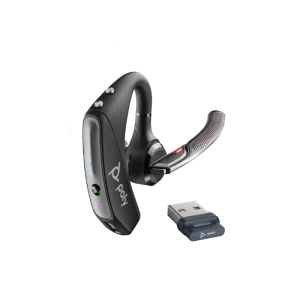 Poly Voyager 5200 UC Headset(PC + Mobile)Add to cart
Poly Voyager 5200 UC Headset(PC + Mobile)Add to cart
-
$219.98
 Poly Voyager Focus 2 UC Headset (w/Stand)(PC + Mobile) & Teams VersionSelect options
This product has multiple variants. The options may be chosen on the product page
Poly Voyager Focus 2 UC Headset (w/Stand)(PC + Mobile) & Teams VersionSelect options
This product has multiple variants. The options may be chosen on the product page
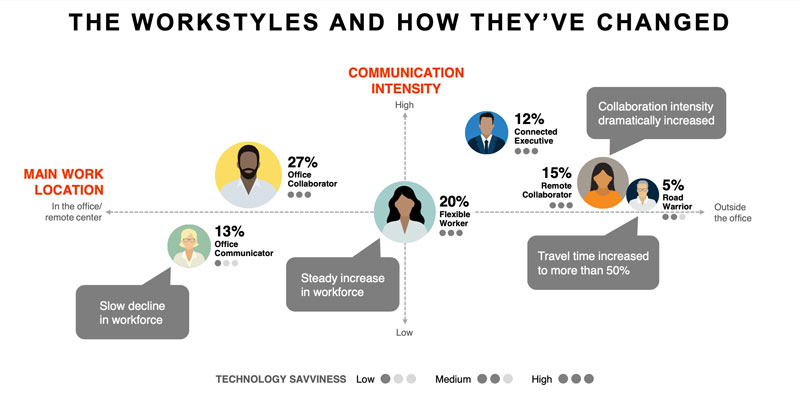
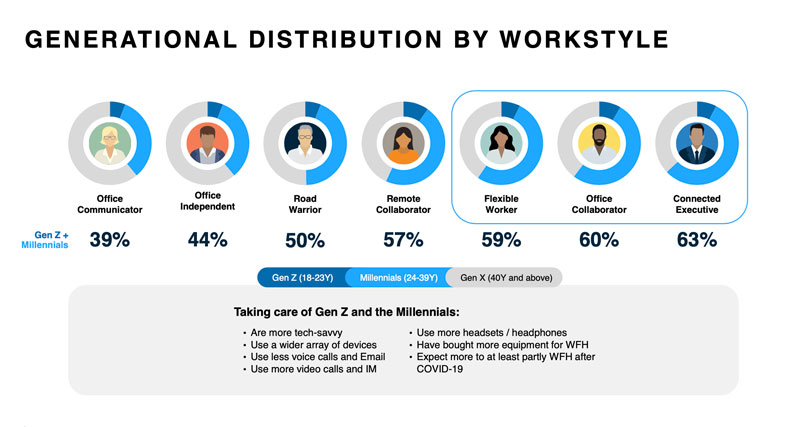
*SOURCE: Factworks: Poly Global Segmentation Research, 2021
